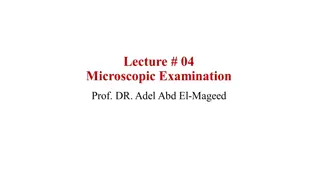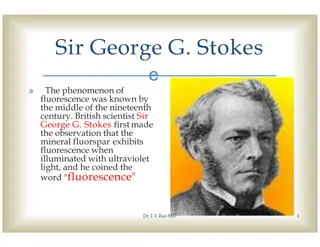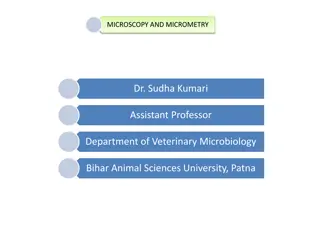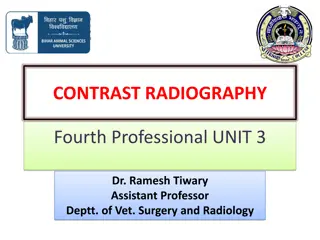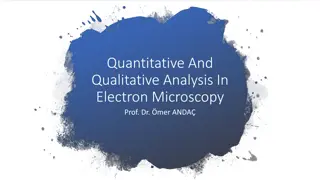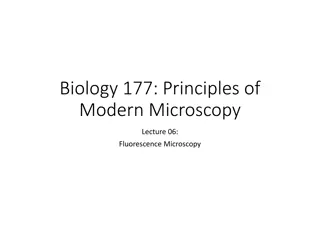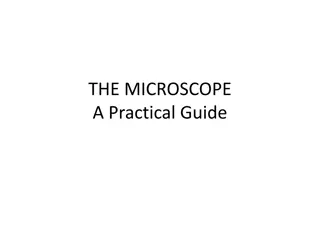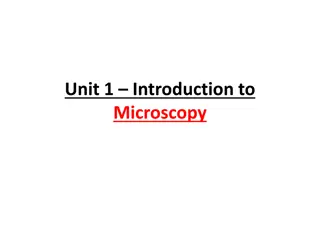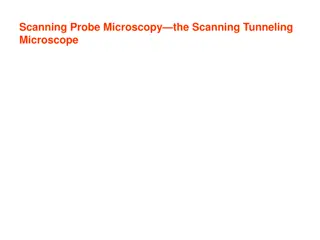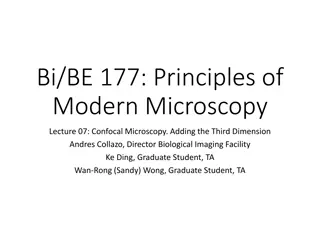Understanding Phase Contrast Microscopy: A Revolutionary Tool in Cell Observation
Phase contrast microscopy, invented by Frits Zernike, revolutionized cell observation by utilizing tiny phase changes in light rays to create contrast in living cells. This technique exploits differences in refractive indices to enhance visibility without staining cells, offering a new perspective in biological research.
Download Presentation

Please find below an Image/Link to download the presentation.
The content on the website is provided AS IS for your information and personal use only. It may not be sold, licensed, or shared on other websites without obtaining consent from the author. Download presentation by click this link. If you encounter any issues during the download, it is possible that the publisher has removed the file from their server.
E N D
Presentation Transcript
UNIT-I MICROSCOPY RASMITA JENA ASSISTANT PROFESSOR SoPLS, CUTM, BBSR
Phase contrast microscopy Frits Zernike a Dutch Physicist invented the Phase Contrast Microscope and was awarded Nobel Prize in 1953. It is the microscope which allows the observation of living cell. This microscopy uses special optical components to exploit fine differences in the refractive indices of water and cytoplasmic components of living cells to produce contrast.
Principle: The phase contrast microscopy is based on the principle that small phase changes in the light rays, induced by differences in the thickness and refractive index of the different parts of an object, can be transformed into differences in brightness or light intensity. The phase changes are not detectable to human eye whereas the brightness or light intensity can be easily detected.
Optical Components of Phase Contrast Microscope The phase contrast microscope is similar to an ordinary compound microscope in its optical components. It possesses a light source, condenser system, objective lens system and ocular lens system (Figure 2.1). A phase contrast microscope differs from bright field microscope in having, (i) Sub-stage annular diaphragm (phase condenser):- An annular aperture in the diaphragm is placed in the focal plane of the sub-stage which controls the illumination of the object. This is located below the condenser of the microscope. This annular diaphragm helps to create a narrow, hollow cone of light to illuminate the object.
(ii) Phase plate (diffraction plate or phase retardation plate):- This plate is located at the back focal plane of the objective lenses. The phase plate has two portions, in which one is coated with light retarding material (Magnesium fluoride) and the other portion devoid of light retarding material but can absorb light. This plate helps to reduce the phase of the incident light (Figure2.2).
Working Mechanism of Phase Contrast Microscopy The unstained cells cannot create contrast under the normal microscope. However, when the light passes through an unstained cell, it encounters regions in the cell with different refractive indexes and thickness. When light rays pass through an area of high refractive index, it deviates from its normal path and such light rays experience phase change or phase retardation (deviation). Light rays pass through the area of less refractive index remain non- deviated (no phase change). Figure 2.3 shows the light path in phase contrast microscope.
The difference in the phases between the retarded (deviated) and un- retarded (non-deviated) light rays is about of original wave length (i.e., /4). Human eyes cannot detect these minute changes in the phase of light. The phase contrast microscope has special devices such as annular diaphragm and phase plate, which convert these minute phase changes into brightness (amplitude) changes, so that a contrast difference can be created in the final image. This contrast difference can be easily detected by human eyes . In phase contrast microscope, to get contrast, the diffracted waves have to be separated from the direct waves. This separation is achieved by the sub-stage annular diaphragm.
The annular diaphragm illuminates the specimen with a hollow cone of light. Some rays (direct rays) pass through the thinner region of the specimen and do not undergo any deviation and they directly enter into the objective lens. The light rays passing through the denser region of the specimen get regarded and they run with a delayed phase than the non-deviated rays. Both the deviated and non deviated light has to pass through the phase plate kept on the back focal plane of the objective lens. The light rays passing through the denser region of the specimen get regarded and they run with a delayed phase than the non-deviated rays.
Both the deviated and non deviated light has to pass through the phase plate kept on the back focal plane of the objective to form the final image. The difference in phase (Wavelength) gives the contrast for clear visibility of the object. Figure 2.4 Microscopic image comparing phase and bright field microscopy.
Applications (Uses) Phase contrast microscope enables the visualization of unstained living cells. It makes highly transparent objects more visible. It is used to examine various intracellular components of living cells at relatively high resolution. It helps in studying cellular events such as cell division. It is used to visualize all types of cellular movements such as chromosomal and flagella movements.
Dark field microscopy Principle: A dark field microscope is arranged so that the light source is blocked off, causing light to scatter as it hits the specimen. This is ideal for making objects with refractive values similar to the background appear bright against a dark background. When light hits an object, rays are scattered in all azimuths or directions. The design of the dark field microscope is such that it removes the dispersed light, or zero order, so that only the scattered beams hit the sample.
The introduction of a condenser and/or stop below the stage ensures that these light rays will hit the specimen at different angles, rather than as a direct light source above/below the object. The result is a cone of light where rays are diffracted, reflected and/or refracted off the object, ultimately, allowing the individual to view a specimen in dark field.
The dark-ground microscopy makes use of the dark-ground microscope, a special type of compound light microscope. The dark-field condenser with a central circular stop, which illuminates the object with a cone of light, is the most essential part of the dark-ground microscope. This microscope uses reflected light instead of transmitted light used in the ordinary light microscope. It prevents light from falling directly on the objective lens. Light rays falling on the object are reflected or scattered onto the objective lens with the result that the microorganisms appear brightly stained against a dark background.
The dark ground microscopy has the following uses: It is useful for the demonstration of very thin bacteria not visible under ordinary illumination since the reflection of the light makes them appear larger. This is a frequently used method for rapid demonstration of Treponema pallidum in clinical specimens. It is also useful for the demonstration of the motility of flagellated bacteria and protozoa. Dark field is used to study marine organisms such as algae, plankton, diatoms, insects, fibers, hairs, yeast and protozoa as well as some minerals and crystals, thin polymers and some ceramics. Dark field is used to study mounted cells and tissues. It is more useful in examining external details, such as outlines, edges, grain boundaries and surface defects than internal structure.
Advantages of Dark field Microscope Dark-field microscopy is a very simple yet effective technique. It is well suited for uses involving live and unstained biological samples, such as a smear from a tissue culture or individual, water-borne, single- celled organisms. Considering the simplicity of the setup, the quality of images obtained from this technique is impressive. Dark-field microscopy techniques are almost entirely free of artifacts, due to the nature of the process. A researcher can achieve a dark field by making modifications to his/her microscope.
Electron microscopy An electron microscope is a microscope that uses a beam of accelerated electrons as a source of illumination. It is a special type of microscope having a high resolution of images, able to magnify objects in nanometres, which are formed by controlled use of electrons in a vacuum captured on a phosphorescent screen. Ernst Ruska (1906-1988), a German engineer and academic professor, built the first Electron Microscope in 1931, and the same principles behind his prototype still govern modern EMs.
Working Principle Electron microscopes use signals arising from the interaction of an electron beam with the sample to obtain information about structure, morphology, and composition. The electron gun generates electrons. Two sets of condenser lenses focus the electron beam on the specimen and then into a thin tight beam. To move electrons down the column, an accelerating voltage (mostly between 100 kV-1000 kV) is applied between the tungsten filament and anode. The specimen to be examined is made extremely thin, at least 200 times thinner than those used in the optical microscope. Ultra-thin sections of 20-100 nm are cut which is already placed on the specimen holder.
The electronic beam passes through the specimen and electrons are scattered depending upon the thickness or refractive index of different parts of the specimen. The denser regions in the specimen scatter more electrons and therefore appear darker in the image since fewer electrons strike that area of the screen. In contrast, transparent regions are brighter. The electron beam coming out of the specimen passes to the objective lens, which has high power and forms the intermediate magnified image. The ocular lenses then produce the final further magnified image.
Types of Electron microscope 1. Transmission Electron Microscope (TEM) The transmission electron microscope is used to view thin specimens through which electrons can pass generating a projection image. The TEM is analogous in many ways to the conventional (compound) light microscope. TEM is used, among other things, to image the interior of cells (in thin sections), the structure of protein molecules (contrasted by metal shadowing), the organization of molecules in viruses and cytoskeletal filaments (prepared by the negative staining technique), and the arrangement of protein molecules in cell membranes (by freeze- fracture).
2. Scanning Electron Microscope (SEM) Conventional scanning electron microscopy depends on the emission of secondary electrons from the surface of a specimen. Because of its great depth of focus, a scanning electron microscope is the EM analog of a stereo light microscope. It provides detailed images of the surfaces of cells and whole organisms that are not possible by TEM. It can also be used for particle counting and size determination, and for process control. It is termed a scanning electron microscope because the image is formed by scanning a focused electron beam onto the surface of the specimen in a raster pattern.
Parts of Electron Microscope Electron Microscope is in the form of a tall vacuum column that is vertically mounted. It has the following components: 1. Electron gun The electron gun is a heated tungsten filament, which generates electrons. 2. Electromagnetic lenses The condenser lens focuses the electron beam on the specimen. A second condenser lens forms the electrons into a thin tight beam. The electron beam coming out of the specimen passes down the second of magnetic coils called the objective lens, which has high power and forms the intermediate magnified image. The third set of magnetic lenses called projector (ocular) lenses produce the final further magnified image. Each of these lenses acts as an image magnifier all the while maintaining an incredible level of detail and resolution.
3. Specimen Holder The specimen holder is an extremely thin film of carbon or collodion held by a metal grid. 4. Image viewing and Recording System The final image is projected on a fluorescent screen. Below the fluorescent screen is a camera for recording the image.
Applications of Electron Microscope Electron microscopes are used to investigate the ultra structure of a wide range of biological and inorganic specimens including microorganisms, cells, large molecules, biopsy samples, metals, and crystals. Industrially, electron microscopes are often used for quality control and failure analysis. Modern electron microscopes produce electron micrographs using specialized digital cameras and frame grabbers to capture the images. The science of microbiology owes its development to the electron microscope. The study of microorganisms like bacteria, virus, and other pathogens have made the treatment of diseases very effective.
Advantages of Electron microscope Very high magnification Incredibly high resolution Material rarely distorted by preparation It is possible to investigate a greater depth of field Diverse applications






